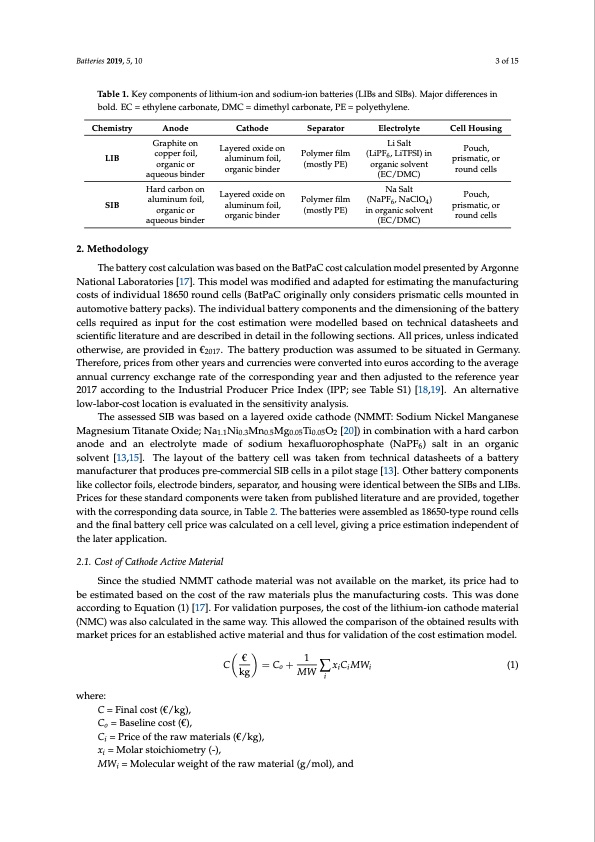
PDF Publication Title:
Text from PDF Page: 003
Batteries 2019, 5, 10 3 of 15 Table 1. Key components of lithium-ion and sodium-ion batteries (LIBs and SIBs). Major differences in bold. EC = ethylene carbonate, DMC = dimethyl carbonate, PE = polyethylene. Chemistry LIB SIB Anode Graphite on copper foil, organic or aqueous binder Hard carbon on aluminum foil, organic or aqueous binder Cathode Layered oxide on aluminum foil, organic binder Layered oxide on aluminum foil, organic binder Separator Polymer film (mostly PE) Polymer film (mostly PE) Electrolyte Li Salt (LiPF6, LiTFSI) in organic solvent (EC/DMC) Na Salt (NaPF6, NaClO4) in organic solvent (EC/DMC) Cell Housing Pouch, prismatic, or round cells Pouch, prismatic, or round cells 2. Methodology The battery cost calculation was based on the BatPaC cost calculation model presented by Argonne National Laboratories [17]. This model was modified and adapted for estimating the manufacturing costs of individual 18650 round cells (BatPaC originally only considers prismatic cells mounted in automotive battery packs). The individual battery components and the dimensioning of the battery cells required as input for the cost estimation were modelled based on technical datasheets and scientific literature and are described in detail in the following sections. All prices, unless indicated otherwise, are provided in €2017. The battery production was assumed to be situated in Germany. Therefore, prices from other years and currencies were converted into euros according to the average annual currency exchange rate of the corresponding year and then adjusted to the reference year 2017 according to the Industrial Producer Price Index (IPP; see Table S1) [18,19]. An alternative low-labor-cost location is evaluated in the sensitivity analysis. The assessed SIB was based on a layered oxide cathode (NMMT: Sodium Nickel Manganese Magnesium Titanate Oxide; Na1.1Ni0.3Mn0.5Mg0.05Ti0.05O2 [20]) in combination with a hard carbon anode and an electrolyte made of sodium hexafluorophosphate (NaPF6) salt in an organic solvent [13,15]. The layout of the battery cell was taken from technical datasheets of a battery manufacturer that produces pre-commercial SIB cells in a pilot stage [13]. Other battery components like collector foils, electrode binders, separator, and housing were identical between the SIBs and LIBs. Prices for these standard components were taken from published literature and are provided, together with the corresponding data source, in Table 2. The batteries were assembled as 18650-type round cells and the final battery cell price was calculated on a cell level, giving a price estimation independent of the later application. 2.1. Cost of Cathode Active Material Since the studied NMMT cathode material was not available on the market, its price had to be estimated based on the cost of the raw materials plus the manufacturing costs. This was done according to Equation (1) [17]. For validation purposes, the cost of the lithium-ion cathode material (NMC) was also calculated in the same way. This allowed the comparison of the obtained results with market prices for an established active material and thus for validation of the cost estimation model. € 1 C kg =Co+MW∑xiCiMWi (1) i where: C = Final cost (€/kg), Co = Baseline cost (€), Ci = Price of the raw materials (€/kg), xi = Molar stoichiometry (-), MWi = Molecular weight of the raw material (g/mol), andPDF Image | Exploring the Economic Potential of Sodium-Ion Batteries

PDF Search Title:
Exploring the Economic Potential of Sodium-Ion BatteriesOriginal File Name Searched:
Exploring_the_Economic_Potential_of_Sodium-Ion_Bat.pdfDIY PDF Search: Google It | Yahoo | Bing
Salgenx Redox Flow Battery Technology: Salt water flow battery technology with low cost and great energy density that can be used for power storage and thermal storage. Let us de-risk your production using our license. Our aqueous flow battery is less cost than Tesla Megapack and available faster. Redox flow battery. No membrane needed like with Vanadium, or Bromine. Salgenx flow battery
| CONTACT TEL: 608-238-6001 Email: greg@salgenx.com | RSS | AMP |